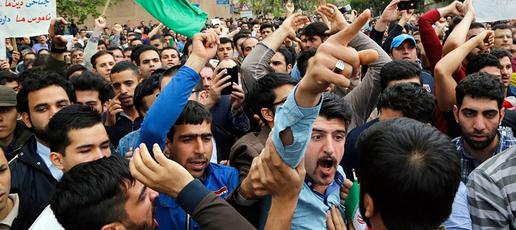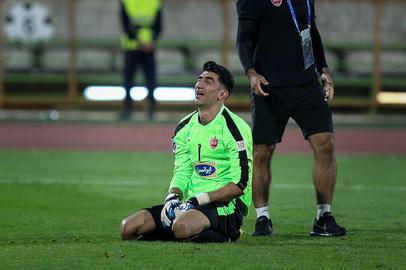During the last days of 2017 and in the first several days of January 2018, cities across Iran were rocked by protests. They started in the holy city of Mashhad, Iran’s second largest city, and focused on rising prices, corruption and the country’s costly involvement in regional conflicts. Some protesters chanted “Death to the dictator!” — referring to Iran’s Supreme Leader. In several cities the protests led to violence, arrests and deaths. The scope and the intensity of protests took Islamic Republic’s civil and security authorities by surprise.
Now a private institute has published a report studying how social networks responded to this wave of protests. The institute, Iran Web [Persian link], was founded in 2010 and offers services such as “data mining,” “text mining,” “social network analysis” and “business intelligence.” A government agency commissioned the research.
According to the authors of the report, the research is based on the study of 800,000 Telegram channels, more than a million Twitter subscribers, 400,000 thousand tweets per day during the period covered, 1,700 news sites and news agencies and 100,000 daily Instagram posts dating from between November 22, 2017 and January 20, 2018. Of these, the study took into account more than 114,000 news items, posts and comments related to the protests; 51,000 protest-related items were unique, meaning they were not shared, re-posted, or re-tweeted.
The following chart provides a snapshot of the sources to which the study referred. (Details follow the chart.)
News items and posts related to the protests first appeared on what the report calls “anti-regime” websites a day after protests in Mashhad broke out. It took three days for domestic sites to publish further items about the unrest. In the end, domestic sites posted 20 times more than the “anti-regime” sites did.
The most active news agency reporting the protests were Tasnim News Agency, which published 4,126 news items, the Islamic Republic News Agency (IRNA), with 2,838 and the Young Journalists Club, an affiliate of the Islamic Republic of Iran Broadcasting (IRIB), which published 2,782 items.
The most active sites outside Iran were Radio Farda, a branch of the US government-funded Radio Free Europe/Radio Liberty (RFE/RL), with 671 news items, and the “Iranian UK” website, with 422. Like many other Persian-language websites outside Iran, the two sites are filtered.
Looking at content, the report finds the top three topics covered in posts and in the news were “foreign support for the protests,” which commanded 23 percent of the topics covered, followed by “people’s demands” at 16 percent and “analysis of the roots of the protests” at 15 percent. Around 30 percent of comments posted on social networks and media “agreed with the protesters,” something that the authors of the report describe as “worrisome.”
The report also analyzes more than 73,000 Telegram channels, which hosted 535,000 posts — there were 3.7 billion views of these posts. The graph below illustrates protest-related activity on Telegram during the period the study covers.
The study shows that 47 percent of the posts on Telegram were “pro-protest” and “anti-regime,” 15 percent supported “peaceful demonstrations” and 25 percent were “against the protests.” The study also analyzed the posts of 83,000 Twitter users and 1.3 million tweets related to the protests. The tweets show a sudden spike after protests in Mashhad started, as the graph below illustrates.
Of the total number of tweets studied, 15 percent “encouraged and incited people to join demonstrations,” 13 percent were about “news of the demonstrations” and 11 percent “insulted political figures and institutions.” Furthermore, 89 percent of the tweets were “supportive of demonstrations,” while only six percent were “against demonstrations.”
An analysis of Instagram posts also shows a sharp spike on the day that the protests started in Mashhad.
Out of Instagram posts related to the protests, the Iran Web research classified 28 percent as “news of protests,” 16 percent as “protesting against the existing situation and demanding change” and 14 percent were “calls to join the demonstrations.” In total, 82 percent of posts assessed on Instagram were “in favor of demonstrations” and 11 percent were “against demonstrations.
Another part of the report analyzes the pages of 83 Instagram virtual “celebrities” and how they responded to the protests. Of these, 83. 31 percent “supported peaceful demonstrations,” 21 percent were in favor of “regime change by overthrowing the Islamic Republic” and 19 percent were “critical of the violent treatment of protesters.”
The December-January nationwide protests were the most significant and unexpected protests since the aftermath of the disputed 2009 presidential election. The difference was that this time protest participants did not belong to the usual “political class.” As usual, of course, the authorities, including the Supreme Leader Ayatollah Khamenei, accused Iran’s “enemies” of instigating the unrest. Some authorities subscribing to this view have repeatedly called for social networks and social media to be banned to prevent foreign “infiltration” — and Telegram was indeed filtered for more than two weeks. This report and its results are bound to make these particular authorities and their supporters less happy, even though it has nothing to say about “enemy” activities.
More on nationwide protests in Iran:
Fresh Protests on Streets of Iran, June 25, 2018
Ayatollah Khamenei Blamed for Recent Protests, May, 2018
Interior Minister Warns of Future Protests — But Offers no Solutions, March 13, 2018
More Protests to Come as Widespread “Discontent and Mistrust” Continues, February 28, 2018
Does Khamenei’s Apology for “Injustice” Mean Anything?, February 19, 2018
Protests in Iran: A Chronology, January 5, 2018
European Citizen Among More than 1000 Arrested in Iran Protests, January 4, 2018
Why Reformists Do Not Empathize with the Protesters, January 2, 2018
Hundreds Arrested in Iran as Protests Continue, January 2, 2018
People Have Left the Reformists Behind, January 2, 2018
A second revolution in Iran? Not yet., December 31, 2017
Eyewitness Reports of Protests at Tehran University, December 31, 2017
Iran Officials Blame Each Other and Foreigners for Protests, December 30, 2017
Isfahan’s Friday Prayers Leader: Praising the Shah Was Shocking, December 30, 2017
Protests in Iran Do Not Spare the Supreme Leader, December 30, 2017
Iran Rocked by Second Day of Street Protests, December 29, 2017
visit the accountability section
In this section of Iran Wire, you can contact the officials and launch your campaign for various problems

























comments